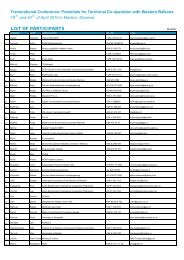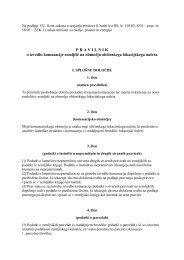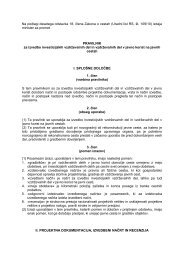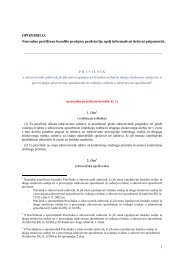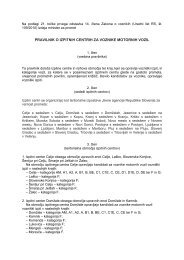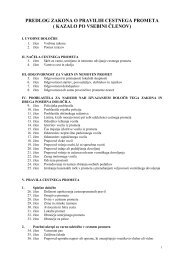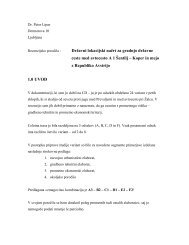evropska konvencija o krajini - Ministrstvo za infrastrukturo in prostor
evropska konvencija o krajini - Ministrstvo za infrastrukturo in prostor
evropska konvencija o krajini - Ministrstvo za infrastrukturo in prostor
You also want an ePaper? Increase the reach of your titles
YUMPU automatically turns print PDFs into web optimized ePapers that Google loves.
222Delavnica 3 / Workshop 3naravnih dejavnikov ter pona<strong>za</strong>rjajo razvojčloveške družbe v času <strong>in</strong> <strong>prostor</strong>u.Družbeno <strong>in</strong> kulturno priznane vrednote sopridobili <strong>za</strong>radi materialnih ostal<strong>in</strong>, kiodražajo preteklo rabo zemljišč, dejavnosti,spretnosti <strong>in</strong> tradicijo, <strong>za</strong>radi upodobitve vknjiževnih <strong>in</strong> likovnih delih ali <strong>za</strong>radipridobljenih <strong>in</strong> izpričanih pove<strong>za</strong>v spomembnimi zgodov<strong>in</strong>skimi dogodki, npr.bitkami <strong>in</strong> drugimi vojaškimi operacijami. Odedišč<strong>in</strong>ski kulturni <strong>kraj<strong>in</strong>i</strong> lahko govorimotudi v primerih kraj<strong>in</strong> z izstopajočoarhitekturo, kot so gradovi, dvorci, cerkve alicelotna naselja, kjer ima kulturna kraj<strong>in</strong>apredvsem vlogo pri poudarjanju <strong>prostor</strong>skegapomena stavbne dedišč<strong>in</strong>e,predstavlja njeno okolico, pogosto pa je z njotudi zgodov<strong>in</strong>sko <strong>in</strong> funkcionalno pove<strong>za</strong>na.II. Evidentiranje <strong>in</strong> vrednotenje dedišč<strong>in</strong>skihkulturnih kraj<strong>in</strong>Prepoznavanje kulturnih vrednot kulturnekraj<strong>in</strong>e (zgodov<strong>in</strong>skih, <strong>prostor</strong>sko členitvenih,vidnih, simbolnih, pričevalnih <strong>in</strong> doživljajskih)izhaja iz njenega <strong>prostor</strong>skega položaja, obsega,<strong>za</strong>ključenosti <strong>in</strong> vizualne ter pomenske razločljivostiglede na drug <strong>prostor</strong>. Subjektivnost zgoljvidnega prepoznavanja dedišč<strong>in</strong>skih kulturnihkraj<strong>in</strong> moramo omejiti s proučevanjem njeneganastanka, funkcionalne <strong>in</strong> zgodov<strong>in</strong>ske pove<strong>za</strong>nostiz naseljem ali posamično stavbnodedišč<strong>in</strong>o. Ob tem je pomembno poznavanjenematerialnih prv<strong>in</strong>, ki so narekovale določenrazvoj kulturne kraj<strong>in</strong>e, kot so tehnika kmetijskepridelave, pove<strong>za</strong>nost z razvojnimi tokovi,duhovna kultura ipd. Ohranjanje dedišč<strong>in</strong>skihkulturnih kraj<strong>in</strong> je neločljivo pove<strong>za</strong>no zohranjanjem druge kulturne materialne <strong>in</strong>duhovne dedišč<strong>in</strong>e.Pri evidentiranju <strong>in</strong> vrednotenju območij, ki jihuvrščamo med dedišč<strong>in</strong>ske kulturne kraj<strong>in</strong>e,upoštevamo tako merila, ki jih je moč opredelitipo povsem spoznavni poti – racionalno, kot tudimerila z doživljajsko – iracionalno noto. Gre <strong>za</strong>evidentiranje <strong>in</strong> vrednotenje <strong>prostor</strong>skih strukturna podlagi poznavanja objektivno določljivihpodatkov o kraj<strong>in</strong>ski zgradbi <strong>in</strong> tudi na podlagiopazovanja <strong>in</strong> dojemanja – doživljanja <strong>prostor</strong>a.Izluščiti je tako mogoče naslednja temeljnamerila:messages, that offer security, comfort, animag<strong>in</strong>ary world or a status symbol. In thecase of designed landscape heritage we protect<strong>in</strong> particular:– the formal concept,– position<strong>in</strong>g <strong>in</strong> the wider physical andhistorical context,– characteristic surround<strong>in</strong>gs and views.2. the cultural (heritage) landscape as special(topographically) delimited parts of thelandscape which have been created throughthe <strong>in</strong>teraction of human and natural factorsand which illustrate the development of humansociety <strong>in</strong> time and space. They haveobta<strong>in</strong>ed socially and culturally recognisedvalues because of the material rema<strong>in</strong>swhich reflect past use of the sites, activities,skills and tradition, because of depiction <strong>in</strong>literary and artistic works or because of acquiredand attested connections with importanthistorical events such as battles andother military operations. We can also talkabout a cultural heritage landscape <strong>in</strong> casesof landscapes with prom<strong>in</strong>ent architecturesuch as castles, mansions, churches or entiresettlements, where the cultural landscapehas above all a role <strong>in</strong> emphasis<strong>in</strong>g thespatial importance of the architectural heritage,represents its surround<strong>in</strong>gs, and is oftenhistorically and functionally connected withit.II. Identification and evaluation of culturalheritage landscapesRecognition of the cultural values of a culturallandscape (historical values; values reflected byland division; visible, symbolic and testimonialvalues; experience-related values) derives fromits spatial position, size, self-conta<strong>in</strong>edness andvisual and semantic dist<strong>in</strong>guishablity with regardto other space. The subjectivity of merely visiblerecognition of cultural heritage landscapes hasto be limited through study of its creation and ofits functional and historical connection with thesettlement or <strong>in</strong>dividual piece of architecturalheritage. Important here is knowledge of thenon-material elements which dictated the specificdevelopment of the cultural landscape suchas techniques of agricultural production, connectionwith development trends, spiritual culture,etc. Conservation of cultural heritage landscapesis <strong>in</strong>extricably l<strong>in</strong>ked to the conservationof other cultural, material and spiritual heritage.



